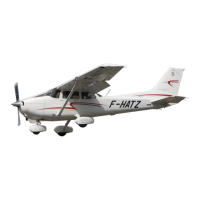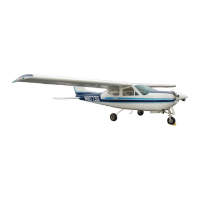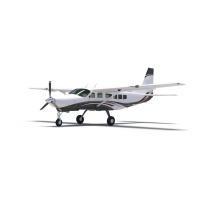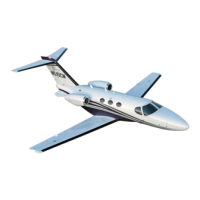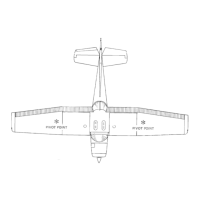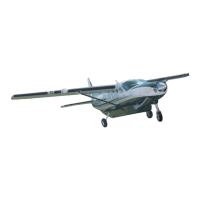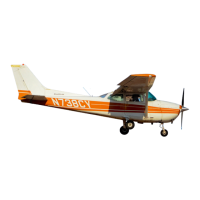Do you have a question about the Cessna C172S Nav III and is the answer not in the manual?
Details the C172S engine specifications, including horsepower, type, and ignition.
Discusses acceptable oil levels, lubrication system, and oil cooler operation.
Describes the two-bladed, fixed-pitch aluminum alloy propeller.
Explains the fixed tricycle landing gear, main gear, and steerable nose wheel.
Details the single-disc hydraulic brakes, master cylinders, and parking brake.
Describes the single-slot type flaps, their operation, and circuit protection.
Covers the pitot-static system, heated pitot head, and alternate static source.
Explains the pneumatic stall warning system and its operation.
Details fuel tank capacity, type of fuel, fuel flow system, and venting.
Describes the 28V DC electrical system, alternator, battery, buses, and circuit breakers.
Explains the dual magneto ignition system and starter operation.
Introduces the G1000 avionics suite, including PFD, MFD, and other components.
Describes AHRS, Magnetometer, ADC, Engine Monitor, Transponder, and XM data link.
Lists and describes various V-speeds for the Cessna 172S.
Presents formulas and data for weight and balance calculations.
Outlines standard operating procedures for passenger briefing and flight instrument checks.
Lists key safety points for passenger briefing.
Details the checks for primary flight instruments before flight.
Covers procedures for engine failure scenarios before rotation.
Describes the steps and standards for a normal takeoff with zero flaps.
Details the procedure and standards for a short-field takeoff using 10 degrees of flaps.
Explains the procedure and standards for a soft-field takeoff using 10 degrees of flaps.
Covers the verbal elements of a VFR landing briefing.
Defines a stabilized approach based on visual cues and descent parameters.
Lists memory items for the before landing checklist.
Outlines the steps and standards for a normal landing with 20 to full flaps.
Details the procedure and standards for a short-field landing with full flaps.
Explains the procedure and standards for a soft-field landing with full flaps.
Describes the power-off 180 landing procedure.
Covers the procedure for using forward slips for landing.
Details the steps for executing an emergency descent.
Explains the procedure and standards for performing steep turns.
Outlines the procedure and standards for slow flight.
Describes the procedure and standards for power-on stalls.
Details the procedure and standards for power-off stalls.
Explains the procedure for performing a rectangular course maneuver.
Details the procedure for executing turns around a point.
Describes the procedure for performing S-turns.
Details the C172S engine specifications, including horsepower, type, and ignition.
Discusses acceptable oil levels, lubrication system, and oil cooler operation.
Describes the two-bladed, fixed-pitch aluminum alloy propeller.
Explains the fixed tricycle landing gear, main gear, and steerable nose wheel.
Details the single-disc hydraulic brakes, master cylinders, and parking brake.
Describes the single-slot type flaps, their operation, and circuit protection.
Covers the pitot-static system, heated pitot head, and alternate static source.
Explains the pneumatic stall warning system and its operation.
Details fuel tank capacity, type of fuel, fuel flow system, and venting.
Describes the 28V DC electrical system, alternator, battery, buses, and circuit breakers.
Explains the dual magneto ignition system and starter operation.
Introduces the G1000 avionics suite, including PFD, MFD, and other components.
Describes AHRS, Magnetometer, ADC, Engine Monitor, Transponder, and XM data link.
Lists and describes various V-speeds for the Cessna 172S.
Presents formulas and data for weight and balance calculations.
Outlines standard operating procedures for passenger briefing and flight instrument checks.
Lists key safety points for passenger briefing.
Details the checks for primary flight instruments before flight.
Covers procedures for engine failure scenarios before rotation.
Describes the steps and standards for a normal takeoff with zero flaps.
Details the procedure and standards for a short-field takeoff using 10 degrees of flaps.
Explains the procedure and standards for a soft-field takeoff using 10 degrees of flaps.
Covers the verbal elements of a VFR landing briefing.
Defines a stabilized approach based on visual cues and descent parameters.
Lists memory items for the before landing checklist.
Outlines the steps and standards for a normal landing with 20 to full flaps.
Details the procedure and standards for a short-field landing with full flaps.
Explains the procedure and standards for a soft-field landing with full flaps.
Describes the power-off 180 landing procedure.
Covers the procedure for using forward slips for landing.
Details the steps for executing an emergency descent.
Explains the procedure and standards for performing steep turns.
Outlines the procedure and standards for slow flight.
Describes the procedure and standards for power-on stalls.
Details the procedure and standards for power-off stalls.
Explains the procedure for performing a rectangular course maneuver.
Details the procedure for executing turns around a point.
Describes the procedure for performing S-turns.
| Manufacturer | Cessna |
|---|---|
| Model | C172S Nav III |
| Engine | Lycoming IO-360-L2A |
| Horsepower | 180 hp |
| Wingspan | 36 ft 1 in (11.0 m) |
| Length | 27 ft 2 in (8.28 m) |
| Height | 8 ft 11 in (2.72 m) |
| Empty Weight (Typical) | 1, 691 lb (767 kg) |
| Cruise Speed | 124 knots (143 mph, 230 km/h) |
| Avionics | Garmin G1000 |
| Seating | 4 |
| Fuel Capacity | 56 US gallons (212 liters) |
| Stall Speed (Flaps Down) | 47 knots |
| Rate of Climb | 3.7 m/s |
| Service Ceiling | 13, 500 ft (4, 115 m) |
| Range | 640 nautical miles |
| Maximum Takeoff Weight | 2, 550 lb (1, 157 kg) |

